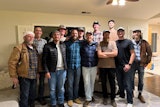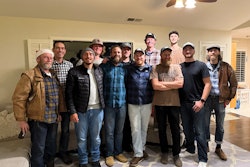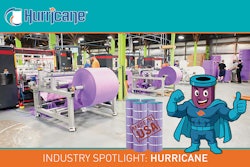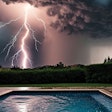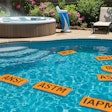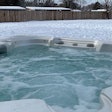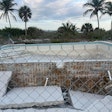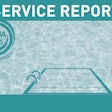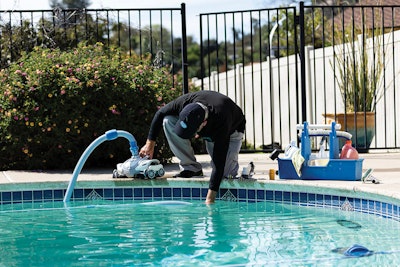
 Austin Gardiner, CEO and founder of GL Pools in San Diego County.
Austin Gardiner, CEO and founder of GL Pools in San Diego County.
In late January, residents of San Diego Country's Otay Mountain neighborhoods were forced to evacuate as fire crews battled one of the many devastating wildfires that ravaged California earlier this year. According to local reports, the 6,625-acre Otay blaze scorched about 10 square miles of remote terrain in the southern San Diego region over a five-day period.
“It was a fairly large fire. Definitely not quite the scale of what was going on in L.A., but we had enough wind at the time, and [firefighters] were not containing it right away,” says Austin Gardiner, CEO/founder of GL Pools, a residential and commercial service company with three locations in San Diego County: San Diego, San Marcos and Santee.
“So part of what we did — and what I’d recommend others in the pool service industry do in a similar situation — is communicate as much as possible with our clients and give them some clear direction about what they should and shouldn’t do regarding their pools.”
One of the most common questions from homeowners was whether they should turn off their pool equipment if ash particles found their way into the water. GL Pools’ answer: No, unless the homeowner knew
with certainty that local officials were going to cut power to their property. GL’s crews did, however, recommend unplugging pool cleaners “so that skimming action can happen, [and] the filter and baskets aren’t getting packed up and restricting flow,” Gardiner says. “We could collect material off the bottom later.”
The company asked homeowners to keep it apprised of what was happening with their pools and reassured them that short-term exposure to ash likely would not cause stains or other lasting damage. (That said, because it’s high in carbon and pH, ash can stain and cause scaling issues if left unattended, says Gardiner, noting that an acid wash often does the trick to remove such unsightliness.)
“We were just trying to help people relax a little bit,” he says. “They had
a lot of other concerns: ‘How are we going to get things off our property? Where are we going to go?’ The last thing we wanted them to do was be too concerned about their pool. There are enough stressful things in life; a pool should not be one of them. So we gave customers information but also encouraged them to just take care of themselves on a more personal level.”
Indeed, sometimes the role of pool professional extends beyond the pool. And even though GL’s client base resides on the periphery of some of the most destructive wildfires in California’s history, Gardiner and his team recognized the human nature
of their business and became, in a sense, amateur psychologists for their customers.
“The good ones do that,” Gardiner says. “Because that means you’re
not viewing the client as a means to an end or a paycheck; you’re viewing them truly as an equal. It takes out
the transactional aspect and becomes more like, ‘Hey, my role here is to be a subject matter expert and to prioritize what you’re thinking and what you’re feeling and try to empathize with that. The fires were popping up everywhere, and everybody was kind of on edge.”
 Ash and debris from the Otay wildfire clouded many backyard pools in San Diego County. GL Pools responded quickly, restoring water clarity and chemical balance while reassuring customers through every step.
Ash and debris from the Otay wildfire clouded many backyard pools in San Diego County. GL Pools responded quickly, restoring water clarity and chemical balance while reassuring customers through every step.
‘ADAPT AND OVERCOME’
Gardiner is a second-generation pool industry professional and has been around long enough to recall some pretty massive wildfires that hit the San Diego area hard, particularly in 2012. So the man knew what he was talking about when counseling clients regarding what to do about their pools during the Otay fire.
And while they did want to know how ash might affect pool water
and what operational procedures they should take, the overwhelming majority of GL’s customers simply seemed appreciative that their pool company had a plan to repair any damage the fire and its fallout caused.
“We told them we were going to adapt and overcome,” Gardiner says. “It was pretty common that people just needed an extra filter cleaning or a few more chemicals. If you get a lot of ash in the pool, it can affect water chemistry because it’s high in phosphates. So we informed them that in three or four months, they might have an algae bloom and not know why.”
After the company’s pool techs removed the ash and cleaned the filter, they tested the customer’s pool for phosphates.
“Phosphates are part of the algae food chain, and if you have elevated phosphates, you can have increased growth rates on algae,” Gardiner continues. “We wanted customers to know that we can get the ash out and the water will look pretty good, but there’s also stuff going on within that water that represents a future problem that we want to provide a solution for. It is our responsibility to inform them about that.”
GL service crews maintained their weekly service routes and quickly were able to clear pools of ash, remove it from filters and other areas, and ascertain whether there were any ash- related water chemistry issues. The company asked customers to refrain from using their pools until a GL tech could come in to clean it and balance the chemicals because, in some cases, the ash might have consumed chlorine and pool sanitizer.
“In the pool industry, we use soda ash to raise pH and sodium bicarbonate to raise total alkalinity,” Gardiner says. “That carbon ash from a wildfire brings up pH, too, and it took additional effort to remove the material and then get the phosphates down closer to zero.”
He estimates that about 30% of GL’s customers use pool covers. Even so, it was difficult to remove a cover without some of the contents on top — especially micro-sized ash particles — finding their way into the water.
When AQUA checked in with Gardiner, the pools that GL services were back to normal. He attributes that to the quick action he and his staff took within a week of the Otay fire’s containment.
“We flagged the ones that really needed attention, because a lot of our pools were not affected,” he says. “We didn’t have to skip service for anybody. The fire got close to one neighborhood and burned the hillside right next to some of those pools. But it was a pretty quick resolution, because we prioritized it.”
‘THAT HUMAN CONNECTION’
GL Pools deployed the same cleaning and chemical balancing process for its commercial clients as it did for its residential customers — and often more quickly, because those facilities typically are serviced several times per week.
Another issue some customers encountered after the Otay fire was mudslides caused by subsequent heavy rains. The soil creating that mud carried iron, phosphates and other metals and minerals that led to sludge at the bottom of pools and, in some cases, required a full drain and refill to properly clean.
In years past, when wildfires left 2 or 3 inches of thick ash on a pool’s floor, a full drain often was necessary, too, according to Gardiner. Crews then used a shop vacuum or even shovels to remove the debris. GL service techs did not need to go to such extremes after this year’s Otay fire, but they still realized that informing pool owners of the potential impact the blaze might have on their backyard investment — and offering reassurance that the company would take care of them — was vital to customers’ mental wellbeing.
Gardiner’s 70-year-old father, Phil, operates Gardiner’s Pool Service
in nearby Santee. “We’ve always collaborated more than competed,” the son says, calling his dad a major influence on his own career — especially in the way the younger Gardiner communicated with clients during the Otay fire.
“His specialty is customer service,” Gardiner says. “That’s the number one thing he taught me, and I wouldn’t want anybody else’s philosophies other than his. He has very pure intentions with all of his clients, and always takes care of them like family. I think that human connection is a superpower for customer service, and it does matter in our industry.”
This article first appeared in the July 2025 issue of AQUA Magazine — the top resource for retailers, builders and service pros in the pool and spa industry. Subscriptions to the print magazine are free to all industry professionals. Click here to subscribe.





















